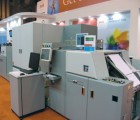Also recently at a conference in Sweden there was an interesting presentation from Alon Bar-Shany, the general manager of the HP Indigo press division. This presentation showed HP’s analysis of the worldwide sales of both offset and digital presses in the past year.
The interesting factor of this was that the number of high quality digital colour presses sold was far greater than offset presses. These figures also showed that the largest number of offset presses were sold in the rest of the world area, but also that this area of the world took the lowest proportion of digital presses.
This is where the interview with Mr Komori becomes really interesting. In this he states that the place he expects considerable further growth is in South East Asia. He also states that the Asian market is obviously Komori’s most important market. He obviously is not saying that the European and North American markets are not important in future, but that Asian is the key for the future.
Komori is obviously looking at where its business prospects are best. It is also possibly reflecting on the facts that it has a limited presence in the digital areas. It does nothing in digital printing, and in reality has a limited presence in digital workflows.
I can see most signifiant initial growth in digital printing will come in North America and Europe where digital workflows are also important, whereas the only areas for offset growth are in the rest of the world, where digital workflows are not so significant. By building on its strengths in Asia Komori may have an advantage over its German competitors in exploiting this area of growth.
One has to consider however whether Komori’s lack of products in the area of workflow may be a hinderance. One of the major benefits of workflow in the Western markets is to allow a very high level of press efficiency together with low manning levels. This is very necessary because of the high wage levels in Western printers A digital workflow however does more than this.
It allows for the addition of new services, such as digital printing, generation of internet content, and the use of the internet for working with customers. As these items become more in demand in Asia it may be that those press supplers with a major support for digital workflows will be the ones that have the most success. Of all the press suppliers Heidelberg has by far the most significant workflow offering, with its Prinect solution, and while Heidelberg does not offer digital presses of its own, it provides links to allow them to be driven by its Prinect workflow.
The question therefore for Komori is whether it is enough to just concentrate on its excellence in offset presses? We are already seeing a major downturn in Western markets for offset presses and one has to wonder how long it will be before we see the same downturn in Asia.
We are also seeing a significant volume of pre-used presses being shipped in the Asian markets and this has a negative impact on the sales of new presses. Heidelberg has generated significant financial problems for itself by increasing its manufacturing capacity in the past years that it is now having difficulty in filling. One has to ask if Komori is making a similar mistake to Heidelberg in massively increasing its manufacturing capacity when the world’s offset press demand is in serious decline.
There is also a further factor that I am sure that Komori has not considered in their plans. We are now starting to see the likely impact of high speed continuous feed color inkjet presses that I believe will move digital printing into the profitable areas of offset printing.
Last week Océ added further models to its Jetstream range of presses and perhaps the most interesting one was the Jetstream 2800. This is a 30inch (75cm) wide press that is aimed at the newspaper and magazine markets. Océ is the second inkjet supplier to produce a press of this width. HP was the first with its Inkjet Web Press shown at drupa, although it has not yet been released.
Unlike other continuous feed inkjet colour presses that are predominantly aimed at direct mail and transactional print applications, these 30inch presses are aimed at offset printing applications. In a presentation at the launch event Océ showed that in colour book printing the crossover point with four-colour perfecting offset printing was around 3,500 books, however the key point was that the time taken to print the books was one fifth of the time taken by an offset press.
These new wider presses are likely to change the buying habits of publishers through the benefits of eliminating mass inventories, as well as other cost and distribution savings. I also expect to see these inkjet developments continuing with the handling of coated substrates that will then move digital printing into magazine production.
While I love offset printing I do see the demand for it in future will diminish. I am not sure if the offset press manufacturers see this and I believe that they feel that demand for presses will go back to previous levels when we come out of the current recession. If the demand does not return companies like Komori and Heidelberg will find that their new manufacturing facilities are unlikely to be filled to capacity.
Comment below to have your say on this story.
If you have a news story or tip-off, get in touch at editorial@sprinter.com.au.
Sign up to the Sprinter newsletter

